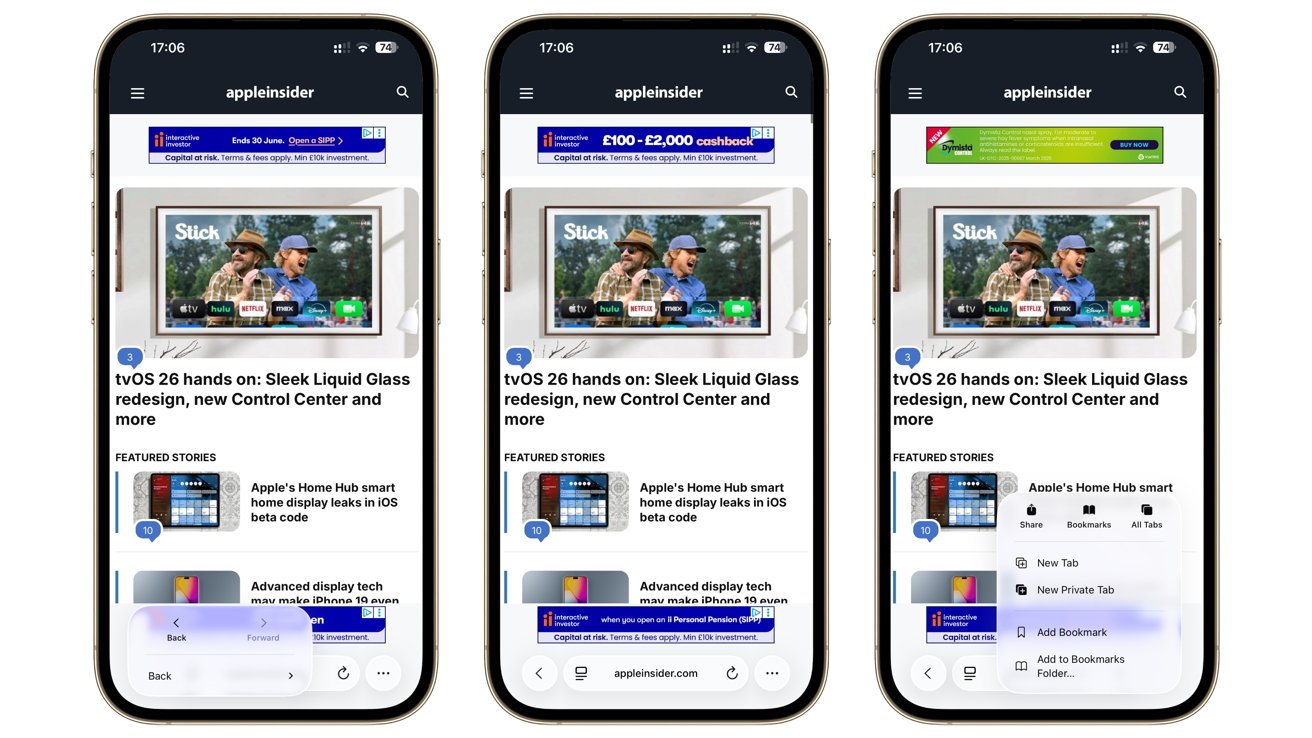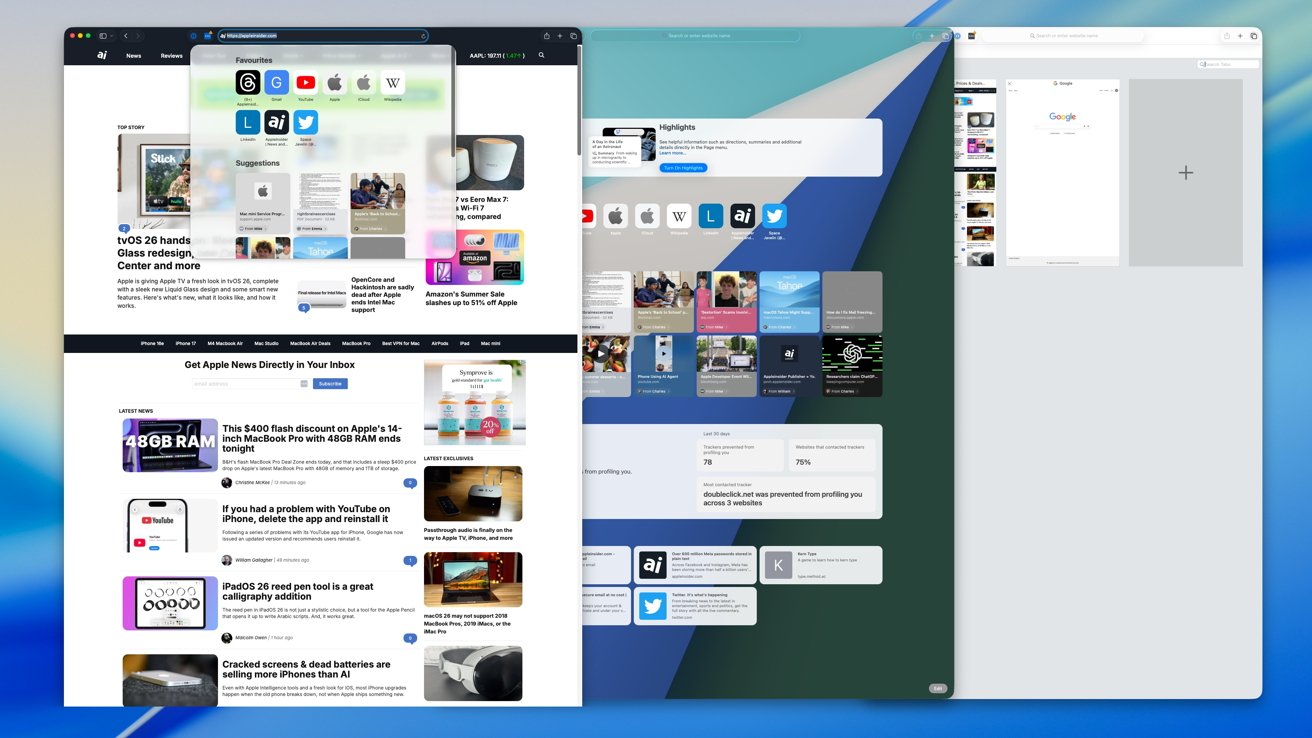Safari’s update for iOS 26, iPadOS 26, and macOS Tahoe brings many UI tweaks as well as changes to Web Apps and HDR photos, alongside many other smaller changes. Here’s what they all look like, and how they work.
The focus of WWDC is on the operating systems, but the changes that are introduced by Apple often affect the apps that run on them. This includes Safari, which has been updated to beta 26 to match the numbering system of iOS 26, iPadOS 26, and macOS 26 Tahoe.
All three browsers get a few obvious changes, but there are many others under the surface that don’t get detailed. According to the Webkit official blog, the beta of Safari 26 has a staggering 67 new features and 107 improvements.
What follows are the main ones that you should care about if you’re a big Safari user.
UI refresh with Liquid Glass
The new UI theme for 2025, Liquid Glass updates the user interface with buttons, panels, and windows that are based on glass. That means lots of transparency and refractions, and an interface for apps that minimizes the menus.
In the case of Safari, that translates to floating address bars, elements that color-match the currently-viewed website, and seemingly fewer buttons than before.
On the iPhone, the address bar is a floating round bar at the bottom of the screen. Instead of having a block with five buttons below the screen, you have a back button and the dots to bring up more options.

The new Safari UI in iOS 26 hides the forward and other buttons from immediate view.
There isn’t an immediately viewable forward button, but if you hold down the back button, a box will appear showing it. Likewise, the bookmarks, tabs, and share sheet are hidden under the dots button.
The upshot is that Safari devotes more of the screen to the website.
This is also a motif that is observed in the macOS and iPadOS versions of Safari, but with the address bar and options at the top of the screen. The tabs open up in its own floating oval bar, if required, with minimal interface buttons in view as well.
It’s a sleeker content-first approach for Safari, which is beneficial to users.
Web App all the websites
Safari users in iOS and iPadOS have been able to convert websites into Home Screen icons since 2008. Doing so would allow websites to appear as a web app, but those that didn’t would open up in Safari as normal.
For the 26 versions, this has changed so that websites open as a web app by default, regardless of whether it was designed to be opened in such a way or not.

Safari, as it appears in macOS 26 Tahoe
While this is useful in most cases, users can still use the Add to Home Screen feature and disable Open as Web App when creating the icon. Disabling the option will open it in the user’s default browser.
HDR photos
HDR content in Safari has been a mixed bag for quite a few years. While Safari 14 added HDR video support in 2020, it didn’t offer the same treatment for high dynamic range images in a webpage.
That changes in Safari 26, as photographs embedded in websites can now be viewed properly, taking advantage of any HDR properties.
To end users, this means being able to see photos on websites vividly and with more color accuracy than was previously available.
SVG iconography
One of the smaller changes is SVG icon support. SVG is a file format that is used for vector images, which makes it ideal for icons that are used in both small and big ways.
The new support applies to pretty much every location in the browser where an icon would be placed. This includes areas like the start page, Favorites, and favicons for websites.
The change will mean little to end users, aside from possibly better-looking website icons that are less blocky at scale.
Webpages in apps, GPU usage, and other developer things
A new API, SwiftUI allows developers to integrate web content into apps made for Apple’s platforms. This includes loading webpages within an app, which can help web developers more easily build proper apps.

Making a web app in iOS 26
WebGPU is a JavaScript API used to run programs on the GPU. Similar to WebGL, it can tap the performance of the GPU to render content in the browser, but with significantly less translation overhead and mapping better to Metal.
This has already been available for over a year in the Safari Technology Preview, but it is shipping in this version of Safari.

An example of a Pretty text wrap function – Image Credit: WebKit blog
Web designers can also use the support for CSS anchor positioning, scroll-driven animations, progress functions, and even a “pretty” text wrap. It really is called Pretty, as it adjust the text wrap to even out the edge of the text to remove pointy sticking-out lines.
While a different operating system, developers with an Apple Vision Pro can also take advantage of immersive video changes. Safari in visionOS includes support for more immersive video types.

